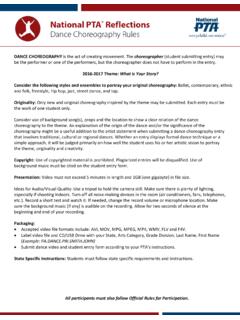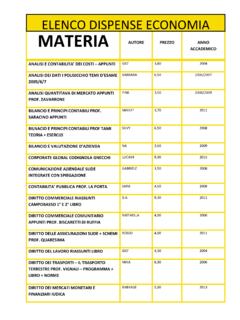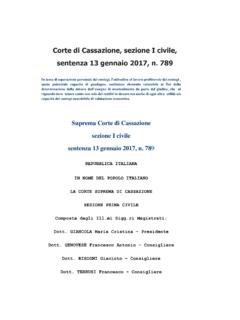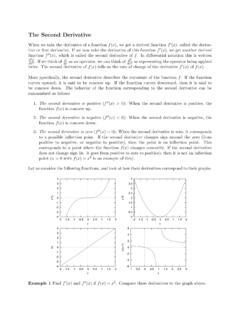Transcription of 15.Applications of Differentiation (A)
1 : applications OF Differentiation Stationary Points Stationary points are points on a graph where the gradient is zero. A stationary point can be any one of a maximum, minimum or a point of inflexion. These are illustrated below. Let us examine more closely the maximum and minimum points on a curve. We notice that a tangent to the curve, drawn at a maximum point, is a horizontal line and hence its gradient is zero. This is also true for the tangent drawn at a minimum point and at a point of inflexion (at a higher level of mathematics, we would discover inflexion points where the tangent is not horizontal).
2 Just before and just after a maximum or a minimum point, the gradient of a curve changes to the opposite sign. In the case of a point of inflexion, though, the gradient does not change sign. If we know the equation of a curve, we can determine the stationary points. This is because at no other point on the graph is the gradient zero, except at a stationary point. The converse is also true. That is, if the gradient at any point is zero, then the point is a stationary point. To obtain the coordinates of the stationary point, we need to find out where on the curve the gradient is zero.
3 Therefore, we first obtain the gradient function, , then, equate it to zero. Next, we solve for x. The values of x obtained will be the x coordinates of the stationary points. We can substitute these values of x into the equation of the curve to determine the corresponding y coordinates of the stationary points. Example 1 Find the stationary points on the graph of . Solution Letting At At Hence, there are two stationary points on the curve with coordinates, ( , 1 ) and (1, 5). The nature of the stationary points To determine whether a point is a maximum or a minimum point or inflexion point, we must examine what happens to the gradient of the curve in the vicinity of these points.
4 In order to do so, we need not sketch the curve. We can use differential calculus to investigate what happens. There are two methods for carrying out this step and both methods will be described. Method 1: Use of the first derivative We can use the first derivative or the gradient function to determine how the gradient changes in the vicinity of the stationary point. At any stationary dydxy=4x3 3x2 6x32243612 6 6yxxxdyxxdx=--=--dydx=012x2 6x 6=02x2 x 1=0(2x+1)(x 1)=01,12xx=-=x= 12,y=4 12 3 3 12 2 6 12 =134x=1,y=4(1)3 3(1)2 6(1)= 5++ ++ - - Copyright 2019.
5 Some Rights Reserved. 1 of , the gradient is zero. By drawing tangents just before and just after the stationary point we observe that the changes in gradient differ in sign depending on the type of stationary point. Figure A: Maximum Point Figure B; Minimum Point A change from positive to zero to negative indicates that the point is a maximum, this is illustrated in Figure A. On the other hand, a change from negative to zero to positive indicates that the point is a minimum as illustrated by the Figure B. When there is no change in the sign, it indicates an inflexion point.
6 As shown in Figure C, these points, the signs of the gradient can either be both positive or both negative, as shown below. This is because they change from positive, to zero at the point, and then to positive again OR from negative, to zero at the point, and then to negative again. Figure C: Points of inflexion In using the first differential to determine the nature of a stationary point, we use the procedure outlined below: 1. Choose a value of x, just smaller and one that is just larger than the x value of the stationary point. For example, if there is a stationary point at x = 2, we may choose x = and x = 2.
7 Calculate for each of these two values of x. 3. By observing the sign change of , we can deduce the nature of the stationary point. 4. If the gradient changes from positive to negative before and after the stationary point, the point is a maximum. 5. If the gradient changes from negative to positive before and after the stationary point, the point is a minimum. 6. If there is no change in the sign of the gradient, the stationary point is a point of inflexion. Example 2 A curve whose equation is has stationary points at ( , ) and (1, 5). Determine the nature of these points.
8 Solution We apply the procedure outlined above, noting that For the stationary point, ( , ), the x-coordinate is 1. We can choose x = as the value just dydxdydxy=4x3 3x2 6xBoth Positive Both Negative Copyright 2019. Some Rights Reserved. 2 of than , and we can choose x = as the value just larger than 2. Calculating for each of these two values, we have 3. The gradient changes from positive to zero to negative. Hence, ( , ) is a maximum point. Repeating these steps for the point (1, 5), we can choose x = as the value just smaller than 1, and choose x = as the value just larger than 1.
9 The gradient changes from negative to zero to positive. Hence, (1, 5) is a minimum point. (Remember, if the gradient ever changes from negative, to zero, at the point, then to negative again OR from positive, to zero at the point, then to positive again, then the point would have been an inflexion point.) Method 2: Use of the second derivative To determine the nature of the stationary points, we can obtain the second derivative and examine its sign at the turning point. The second differential is also a function and obtained by differentiating the first derivative.
10 It represents the derivative of the gradient function and it specifies the rate of change of the gradient function. If the second derivative is positive then the gradient increases as you move along the curve with the gradient increasing from negative just before the point to zero at the point and to positive just after the point. This pattern indicates that the point is a minimum point. Minimum point The tangent at A has a negative slope, the tangent B has a zero slope and the tangent at C has a positive slope. As we move from left to right, the slope of the tangent increases, so the second derivative is positive.

















